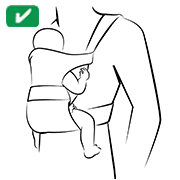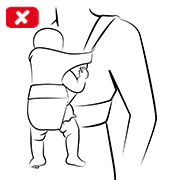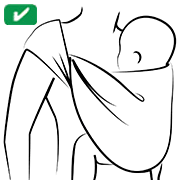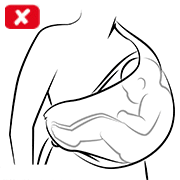Never Search Up Babe Again Warning
About baby carriers, slings and backpacks
Baby carriers, baby slings and babe backpacks are different types of equipment for carrying your infant on your breast or back.
A baby carrier is a soft padded carrier that you habiliment on your forepart. Some have adaptable options so you can clothing your baby on your dorsum or hip.
A baby sling is a pouch or strip of fabric, usually secured over your shoulder and worn across your front end in diverse positions.
Infant backpacks usually take rigid frames. You article of clothing them only on your dorsum. They're suitable for older babies and toddlers who can hold up their heads. It'southward a good idea to enquire your GP or child and family health nurse whether your babe is old enough for a haversack.
Carrying your baby in a baby carrier, sling or haversack gives you the advantage of having your hands complimentary, and most babies like being able to run across the earth from upwardly loftier. If you use carriers, slings and backpacks the right way, they're condom and practical ways to go around with your babe.
What to expect for in a baby carrier
If yous're interested in baby carriers, it'south important to expect for one that:
- allows good for you hip positioning for your infant
- is rubber to employ
- is comfortable for you to habiliment.
Healthy hip positioning
Healthy hip positioning encourages normal hip development in babies and reduces the chance of developmental dysplasia of the hip.
Your baby carrier should let your baby's hips to spread and so their legs are straddling your body. Your infant'southward knees should be spread autonomously, the thighs should be supported, and the hips should be bent.
Here's how to behave your babe for good for you hip positioning, plus what non to do.


Carrying your baby with their hips together within a sling can increment the run a risk of hip dysplasia.


These images are reproduced with permission from the International Hip Dysplasia Institute.
Safe baby carriers and slings
In that location is no Australian standard for babe carriers, slings and backpacks. But the following tips tin help you cull a safe infant carrier:
- Expect for a baby carrier with the European standard EN 13209-ii:2005 or the US standard ASTM F2236-08.
- Check that the carrier or sling comes with easy-to-understand written, visual or video instructions that show you how to apply it safely.
- Take your baby with you when you're shopping for a carrier or sling. Inquire a store assistant to bear witness you how to fit the carrier or sling correctly with your baby in it.
- Your baby should exist able to move their head, arms and legs.
- Check that your infant can see out of the carrier or sling and that the cloth doesn't cut into their confront.
- Make sure you can put the carrier or sling on and take it off without any assistance. Too ensure that you tin exercise up whatever buckles, straps or clips without help and that you can conform all straps firmly with i hand.
- With a sling, brand sure it doesn't embrace your baby'south face or strength them into the fetal position.
Comfortable infant carriers
The best way to detect a comfortable baby carrier is to try on different styles with your babe. If your partner and other carers will be using the carrier, look for a way that will be comfortable for them too.
Hither are a few tips for choosing a comfortable baby carrier:
- Look for broad, padded shoulder straps that go across your dorsum, also as a broad waist strap. These will help to distribute your baby's weight evenly and continue some pressure off your shoulders. They should likewise cease the carrier moving from side to side too much.
- Ensure the carrier is appropriate for different seasons and won't make your baby overheat in the warmer months.
- If you lot program to use the carrier as your baby grows, look for a carrier that you can change around and so your babe tin confront frontward.
- Use your carrier just until your baby feels also heavy or uncomfortable to acquit safely. Check the carrier's instructions for the maximum weight the carrier can handle.
Baby carriers aren't recommended for babies under four months of age or babies who can't hold upwards their heads yet. This is because they're at greater risk of neck injuries.
Using a infant carrier, sling or backpack safely
Here's how to secure your babe in a carrier, sling or haversack and employ this equipment safely.
Securing babies in carriers, slings and backpacks: full general tips
- Read the tags for elevation and weight, and utilize the right infant carrier for your baby's size.
- Tighten the straps before yous put your baby in the carrier, and so use the straps to get a snug, secure fit.
- Make sure you tin can arrange all straps firmly with one paw.
- Try to get into the habit of checking that the straps are still secure and prove no signs of damage earlier putting your infant in each time. If any straps or buckles are damaged, contact the supplier or manufacturer.
- Go someone to aid you put your baby in the carrier until you get used to doing it on your own. Some people find information technology helps to practise with a doll or teddy before putting the babe in.
Using carriers, slings and backpacks: general tips
- Habiliment shoes that are easy to walk in, and expect out for uneven surfaces then you don't trip.
- Avoid using carriers in hot weather, considering your body heat and the carrier will increment your infant's temperature.
- Take care when putting on and taking off the carrier, because this is when falls are most mutual. If you can, get somebody else to help you, or sit downwards on the floor.
- Hold on to something stable – similar a pole – if yous bend downwards or lean forward while wearing the sling, carrier or backpack.
- If yous're cooking, don't deport your baby in a front end-wearing carrier or sling because of the risk of burning your baby.
- Avoid holding hot nutrient and drinks, running afterward other children and doing anything else that could be unsafe.
Concrete activeness is vital to your infant's healthy growth and development. Aim to balance any fourth dimension your babe spends in baby carriers or slings with enough of tummy time and other physical activity.
Infant slings: fugitive suffocation risks
Babies are at run a risk of suffocation if they're not correctly put into baby slings. This is considering young babies can't move if they're in a dangerous position that's blocking their airways.
The T.I.C.K.Southward. dominioncan assist yous remember how to position your baby safely in a babe sling:
- Tight: the sling should be tight, with the baby positioned high and upright with head support. Any loose fabric might cause your baby to slump downward, which could restrict animate.
- In view at all times: y'all should e'er be able to run into your baby'south face by but looking down. Ensure your baby's face, olfactory organ and mouth remain uncovered by the sling and/or your body.
- Close enough to osculation: your baby should exist close enough to your chin that by tipping their head frontwards yous tin can easily kiss their head.
- Keep chin off the chest: ensure your baby'south chin is up and away from their body. Your baby should never be curled so that their mentum is forced onto their chest. This can restrict breathing. Regularly check your infant. Babies tin exist in distress without making any noise or movement.
- Supported dorsum: your baby's back should be supported in a natural position with their breadbasket and chest against you. When bending over, back up your baby with one mitt behind their back. Curve at the knees, not at the waist.
Accept your baby out of the sling or carrier straight away if you notice that:
- your babe'southward face is covered or their mentum is tucked in
- your infant is curled into the fetal position
- your baby is grunting, wheezing, or taking laboured, rapid or whistling breaths
- there's a grayness or blue tinge to your baby's peel
- your baby is fussy, restless or squirming.
Babies who were premature, had low nascence weight, are unwell, or are under four months of historic period are at greater risk of suffocation in baby slings. Talk to your child and family health nurse, GP or paediatrician earlier using a sling.
Source: https://raisingchildren.net.au/newborns/safety/equipment-furniture/baby-carrier-sling-safety
0 Response to "Never Search Up Babe Again Warning"
Post a Comment